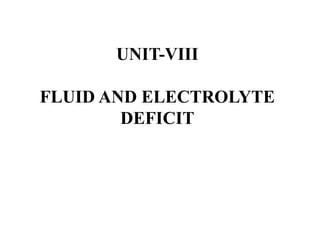
dehydration own.pptx
- 2. A condition that results from illness ; a hot, dry climate; prolonged exposure to sun or high temperatures; not drinking enough water; and overuse of diuretics or other medications that increase urination?
- 4. DEHYDRATION Dehydration is a condition that occurs when the body loses too much water and other fluids that it needs to work normally. It occurs when more water and fluids leave the body than it enter. Dehydration can be defined as when the loss of water and salts is more than is replenished. The average person loses about 2.5 liters of water every day. So to stay properly hydrated you must replenish this water in order to keep from being dehydrated.
- 5. LOSS CAN : 1. Mild : loss to 1 to 2 L of water (2% body weight is lost) 2. Moderate : Loss to 3 to 5 L of water (5% body weight is lost) 3. Severe : Loss of 5 to 10 L of water (8% of body weight is lost)
- 6. CAUSES AND RISK FACTOR Causes: Not drinking water Physical exercise Sweat excessively Fever Vomiting Frequent urination Kidney Failure Burns High level of glucose Diarrhea Use of Diuretics Drinking too much alcohol
- 7. PEOPLE AT RISK : 1. Babies and infants : They have low body weight and are sensitive to very small amount of fluid loss. 2. Older people: They may be less aware that they are becoming dehydrated and need to keep drinking water. 3. People with chronic illness 4. People who work / exercise: Athletes
- 8. CLINICAL MANIFESTATIONS OF DEHYDRATION Feeling thirsty Dry mouth Less frequent urination Dizziness Dark color urine Dry skin Feeling tired Lethargic Fainting Confusion Reduced skin elasticity Muscle cramps Light headedness Fast heart rate Fast breathing Irritability
- 10. SIGNS OF MILD DEHYDRATION
- 12. ORAL REHYDRATION SALT (ORS) • What are the constituents? The composition of the new, reduced osmolarity ORS, as recommended by WHO, is as follows: • Sodium chloride—2.6 g • Glucose (anhydrous)—13.5 g • Potassium chloride—1.5 g • Trisodium citrate dehydrate—2.9 g (Total weight of a packet = 20.5 g) The new ORS was launched by WHO in January 2004 and in India in June 2004.
- 13. • How is the ORS reconstituted? The contents of the packet are dissolved in 1 L of drinking water. • What is the role of each of the constituents? • Glucose facilitates absorption of sodium and hence water. • Sodium and potassium replace the loss of these essential elements in diarrhea and vomiting.
- 14. • What is the indication? Mild and moderate dehydration • What are the instructions given regarding reconstitution? • Dissolve the entire content of the packet in 1 L of clean drinking water. • The prepared solution should be used within 24 hours. Discard the solution left after 24 hours. • The solution should be made fresh daily. • It should not be boiled or sterilized otherwise.
- 15. • How will you manage when these packets are not available? If this mixture is not available, a simple sugar and salt solution can be prepared as follows: • Table salt—5 g • Sugar—20 g • Water—1 L Dissolve the salt and sugar in 1 L of water.
- 17. DIAGNOSTIC EVALUATION 1. History collection 2. Physical examination • { vital signs} • {Capilary refill time} • { Poor Skin Turgor} 3. Complete blood count
- 18. MEDICAL MANAGEMENT Initial evaluations may include: 1. Mental status tests to evaluate whether the patient is awake, alert, and oriented. 2. Vital sign assessments may include postural readings (blood pressure and pulse rate are taken lying down and standing). With dehydration, the pulse rate may increase and the blood pressure may drop because the intravascular space is depleted of water.
- 19. • 3. Temperature may be measured to assess fever. • Skin will be checked to see if sweat is present and to assess the degree of elasticity. As dehydration progresses, the skin loses its water content and becomes less elastic
- 20. NURSING MANAGEMENT 1. Urge the patient to drink the prescribed amount of fluid. Oral fluid replacement is indicated for mild fluid deficit and is a cost-effective method for replacement treatment. Older patients have a decreased sense of thirst and may need ongoing reminders to drink. 2. Monitor and document vital signs, especially BP and HR. A decrease in circulating blood volume can cause hypotension and tachycardia. Alteration in HR is a compensatory
- 21. Assess skin turgor and oral mucous membranes for signs of dehydration. Signs of dehydration are also detected through the skin. The skin of elderly patient’s losses elasticity; hence skin turgor should be assessed over the sternum or on the inner thighs. 4. Assess color and amount of urine. Report urine output less than 30 ml/hr for two (2) consecutive hours. Normal urine output is considered normal, not less than 30ml/hour. Concentrated urine denotes fluid deficit. 5. Monitor fluid status in relation to dietary intake. Most fluid comes into the body through drinking, water in food, and water formed by the oxidation of foods. Verifying if the patient is on a fluid restraint is necessary
- 22. COMPLICATIONS: Untreated Severe dehydration • Death • Permanent brain damage • Seizures
- 23. NURSING DIAGNOSIS Fluid volume deficit related to insufficient fluid intake as evidenced by Decreased urine output.
- 24. THANK YOU